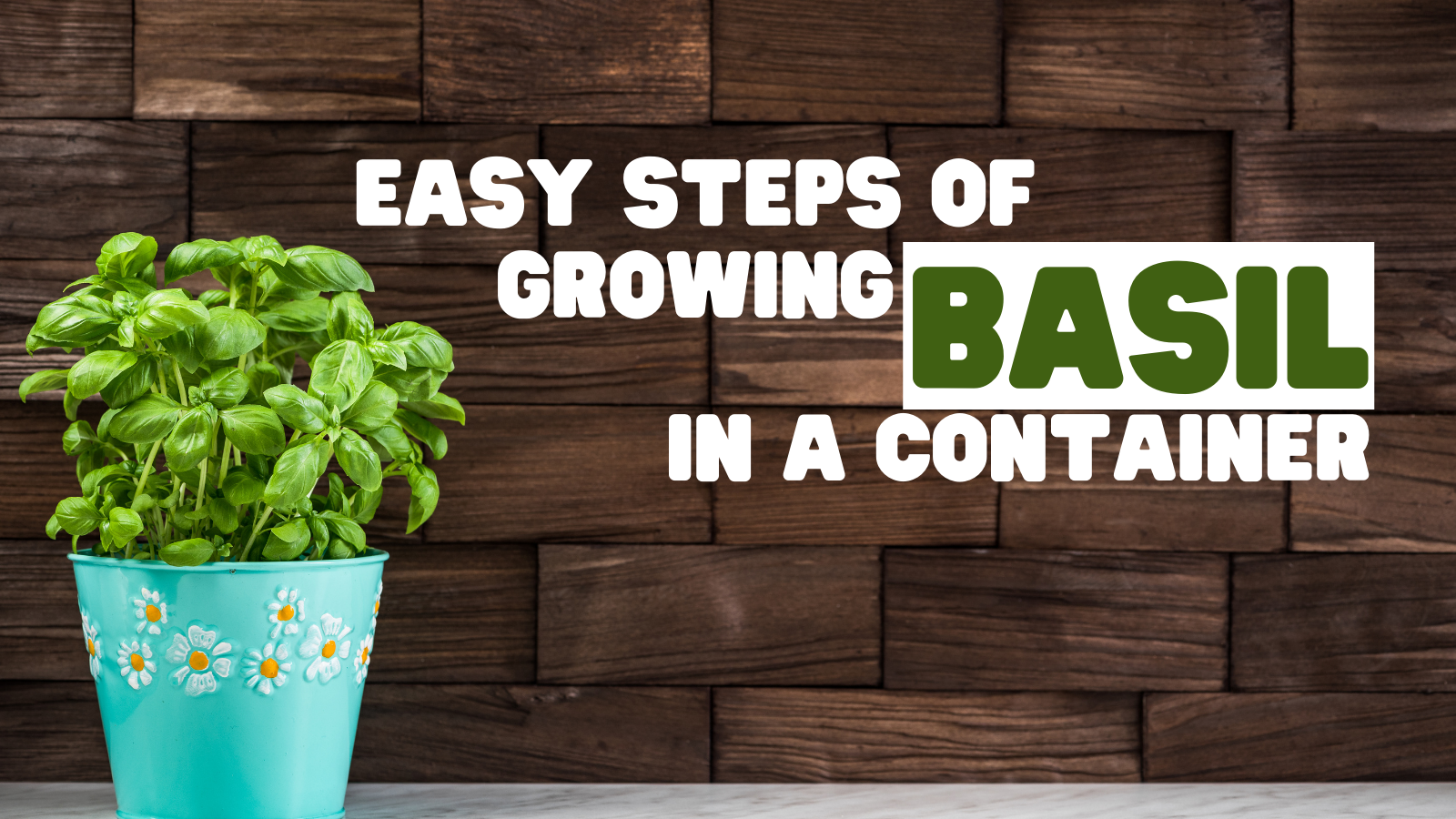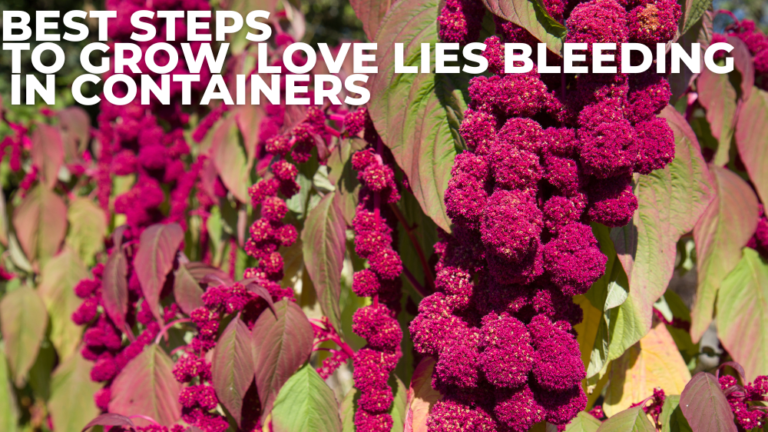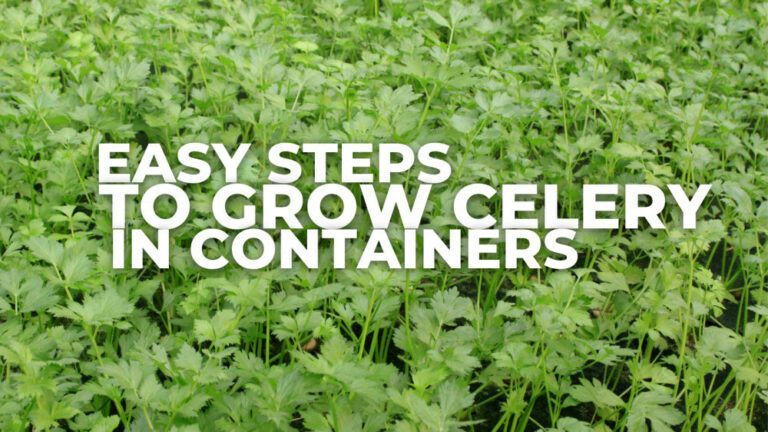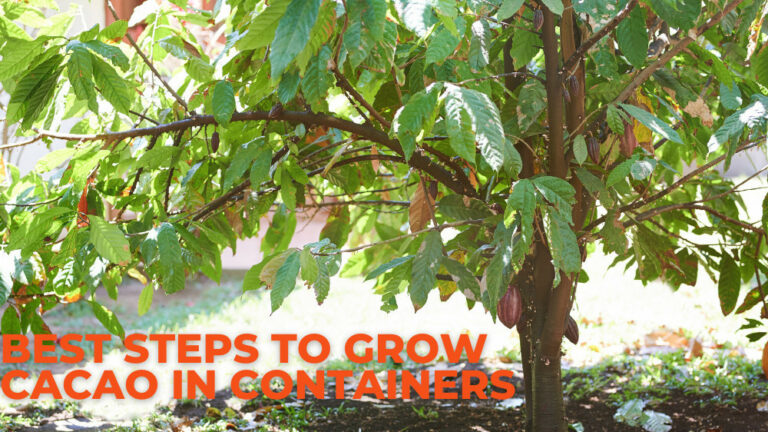Easy Steps Of Growing Basil In A Container
Easy Steps Of Growing Basil In A Container
Basil is one of the most incredible and most adaptable culinary herbs, and it smells fantastic. And best of all, basil grows nicely in pots, making it ideal for a deck or patio herb garden.
With a little care and attention, you'll have fresh basil to create pesto, add to spaghetti sauce or soup, or top pizza. You can also quickly dry and store it for all-year usage.
Basil isn't difficult to cultivate, but it may be picky about sun, water, and temperature. Try to follow all of my steps; these steps will be helpful for you to grow basil in a container ideally.
Origin Of Basil
Basil (Ocimum basilicum), often known as large basil, is a Lamiaceae family culinary plant (mints). It is a delicate plant utilized in cuisines all over the world. The variation, also known as sweet basil or Genovese basil, is referred to as “basil” in Western cuisine. Basil is a tropical plant that is native to Central and Southeast Asia.
Basil is typically grown annually in temperate settings, but in warmer horticultural zones with tropical or Mediterranean temperatures, basil can be produced as a short-lived perennial or biennial.
Basil is a leafy annual or perennial plant farmed for its leaves. Plants can grow 30 to 150 cm tall, depending on the cultivar (1 and 5 ft). Its leaves are dark green and oval, although depending on the cultivar, they come in various sizes and shapes depending on the cultivar.
Leaf lengths range from 3 to 11 cm (1 to 4½ in) and widths from 1 to 6 cm (½ to 2½ in). Basil develops a sizeable central taproot. It has little white flowers that grow from a central inflorescence, or spike, that arises from the plant's central stem. The four stamens and pistil are not pushed under the upper lip of the corolla but rather lie over it, which is unusual among Lamiaceae.
Basil leaves are shiny and oval, with smooth or slightly serrated edges that cup slightly and are grouped oppositely along square stems. The tiny flowers are white to magenta and are borne in terminal clusters. The plant is frost-sensitive and thrives in warm environments.
Types Of Basil
Basil can instantly improve any dish, and you can grow it in your backyard or on a windowsill. We'll go over all of the many types of basil and explain what makes them unique. Basil comes in 50 to 150 different varieties.
Plants that thrive in warm climates are grown all over the world. While each species is unique, most are Sweet basil cultivars, with a few hybrid species thrown in for good measure. To grow basil in a container, you should find out the best variety for your zone.
1. Sweet Basil
The most popular basil type is sweet basil, which is great in pestos, salads, and marinades. Sweet basil is a medium green leaf with a spherical cup shape. Mosquitoes are said to avoid sweet basil. The sweet basil cultivar is the most common basil found in the grocery store.
2. Genovese Basil
Genovese basil is traditional Italian with huge dark green leaves. This basil is particularly delicious in pestos and other Italian dishes. The leaves of Genovese basil are flatter and more pointed than those of Sweet basil. Sweet and Genovese basil are used interchangeably in some cultivars, making the sweet plant Genovese basil. True Genovese has a more fragrant and potent flavour.
3. Purple Basil
Purple basil has a deep maroon colour that significantly contrasts the herb garden. The flavour is less sweet than other basil varieties, with a stronger clove flavour. Purple basil is incredibly fragrant and may be soaked in vinegar or oil to give your meals a wonderful hue.
Dark Opal Purple basil grows to be 18 inches tall. A few plants (about 20%) will be variegated or green, resulting in a lovely colour mix. It has massive leaves that may reach one and a half inches in length when completely grown. Dark Opal basil matures in 80 days.
4. Lemon Basil
Lemon basil is a popular variety that is becoming more common in local nurseries and garden shops. Lemon basil grows between 12 to 18 inches tall with light green leaves.
Crush a leaf between your hands to inhale the lovely citrus scent of this variety. Nothing compares to the flavour of fresh lemon basil. Lemon basil may be used in fish or poultry marinades, grilled veggies, desserts, and drinks.
5. Lime Basil
Lime basil has a citrus flavour that is sweet, light, and lively. The leaves are thin and bright green. Lime basil can reach a height of 16 to 24 inches. While lemon basil is more well-known, some gardeners blend the two in herb gardens. When cooking, the two tastes complement each other well, bringing out the lemon and lime flavours. It can help with sauces, desserts, and drinks.
6. Lettuce Basil
Lettuce basil has vast, floppy wrinkled leaves that give it a characteristic appearance. As the name suggests, it goes nicely with salads and other light foods. The lettuce basil leaves measure four inches wide by six to ten inches long. Because of this, it's great for lettuce wraps, while most other basils would be far too little.
Lettuce leaf basil is mild-flavoured Italian basil. The plant itself is fairly little, despite the size of the leaves. It's one of the smallest basils, at around a foot tall. It also takes a long time to blossom, so it can withstand the summer heat for a bit longer before going to seed.
7. Green Ruffles
The curled leaves of Green Ruffles Basil make it gorgeous basil to cultivate in the yard. The mild and delicate flavour pairs well with pasta meals.
Because of its ruffled leaves, this basil is especially good for salads. Green Basil ruffles grow higher than sweet basil, reaching up to 24 inches.
The leaves are also rather enormous, ranging between four and six inches in length. It is ready for harvesting as soon as 70 days after planting.
8. Holy Basil
Holy basil has a spicy, sweet, and musky scent.
The taste is best when cooked because it is a little bitter when eaten raw. Holy basil is widely used in meat curries in Indian cuisine.
In South Asia, holy basil is known as tulsi, which means “the incomparable one.” In Hinduism, it is considered a sacred plant. Holy Basil has numerous medical and religious applications. Holy basil is used to heal stomach and kidney problems, and to improve circulation.
9. Cinnamon Basil
Cinnamon Basil is a fragrant and spicy basil variety. Cinnamon basil is another gorgeous plant in the herb garden. The stems mature to a reddish-purple tint with pink blooms.
Cinnamon Basil has a milder basil flavour than typical basil and complements fruit well, providing a slight zing to the cinnamon flavour. It's also a common herb in Asian cooking. It's great in Asian marinades, fried rice, noodle salads, and grilled veggie salads.
10. Greek Basil
Greek basil is one of the smallest basil varieties, growing to around 8 inches. It has small, pointy leaves and a compact form. Salads, soups, and meat dishes are frequently seasoned with Greek basil. A sprig of Greek basil can also be used as a garnish.
Greek basil is easy to cultivate in a pot. It may be utilized in the kitchen or outside with other ornamentals. It can be highly appealing when planted on the border with other low-growing plants like pansies or violas.
11. Spicy Globe Basil
Another dwarf basil strain is Spicy Globe. It has a strong, spicy flavour and tiny leaves in soups, salads, and pasta. It's also known as Spicy Bush or Boxwood Basil because it grows in a compact clump. With a rounded top, it resembles a miniature boxwood. This basil variety is ideal for growing in containers and indoor gardening.
12. Curly Basil
Curly Basil is a hardy variety with firmly curled leaves. It has a sweet taste that is great for cooking. 8-24′′ in height. Bushy shrub with oblong, glossy, brilliant green leaves to 2′′ long, typically with a serrated edge. White blossoms on spikes should be eliminated since they deplete their energy.
13. Boxwood Basil
Boxwood basil is not confused with the Boxwood plant, a tiny shrub, but it is edible. It does, however, grow in the shape of a tiny shrub, reaching just 12 inches in height. If you need a border plant, boxwood basil is an excellent choice. It's commonly used in Italian recipes and makes a flavorful pesto sauce.
Growing Basil In A Container
Basil is a versatile and attractive herb. Basil comes in a variety of varieties, with new ones being introduced each year. Curly basil, dark opal basil, and typical Genovese basil are all excellent choices. Bush basil's small leaves are both delicious and attractive. Basil comes in a variety of flavours and purposes.
Basil can be used to flavour flowers, teas, soups, and nearly any seafood dish. It also dries and freezes nicely, allowing you to utilize it throughout the winter. In small jars or ice cube trays, basic basil pesto, for example, freezes well.
Growing basil is not easy. Here are some suggestions for growing attractive, bushy hair.
Choose A Container For Basil
Basil can be grown in nearly any environment. Any container, including a kiddie pool or even a laundry basket, will work. Basil prefers a lot of space so that air may circulate around the plants. It also doesn't like to dry out completely, therefore a large pot is recommended.
You don't want to crowd your plants, but if you're constructing your pot for both beauty and function, you can put them closer together than the usual 12 to 18 inches apart. Try spacing them 6 to 8 inches apart. Basil, on the other hand, is susceptible to fungus, thus maintaining airflow between plants is critical.
Make sure your pot has adequate drainage and that the potting mix is of good quality. Basil dislikes being wet, so keep the soil moist but not waterlogged. Make use of fabric pots. You can even put the cloth pot in a larger vessel for a more polished look.
Grow Basil From Seed
Basil is quite simple to grow from seed. About a month before your last frost date, you can direct seed or start your seeds inside. It's important to remember that you'll want to put them outside around two weeks following the latest frost date. Basil needs sunshine to germinate, so the seeds are only quarter-inch deep.
Temperatures around 70 degrees Fahrenheit are ideal, but you can adjust the temperature. Plants need five to ten days to germinate. When the plants have three to four leaves, carefully transplant them. Basil can also be rooted in water. Take a plant's stem and place it in a clear vase or glass of water. You can transplant out (after hardening) once roots emerge.
Soil Requirements Of Basil
Basil grows well on moist, well-drained soil with a neutral pH. At the start of the season, I amend the soil with thick compost. There isn't much additional soil amendment required. In fact, basil loses some of its taste strength when the soil is overly rich. Basil prefers a pH of 6 to 7 and prefers rich, moist, but well-drained soil.
Test your soil or simply improve it by adding organic nutrients such as compost, blood meal, or cottonseed meal. Alternatively, simply add a few inches of ancient compost-enriched soil. To the top layer of your native soil, apply Miracle-Gro Performance Organics All-Purpose In-Ground Soil. If planting in a container, use a large pot to protect the plants from drying out too rapidly in hot weather.
Fill the pot with Miracle-Gro, Performance Organics All-Purpose Container Mix, which incorporates compost but is lighter and fluffier than in-ground soil, making it ideal for container gardening.
While rich, nutritious soil is ideal for growing basil, you'll get even greater results if you feed your plants on a regular basis, especially since basil is heavily harvested for its leaves.
Use Miracle-Gro Performance Organics, and Edibles Plant Nutrition to fertilize your basil. It feeds your plants, but it also feeds the beneficial bacteria in the soil that help those plants absorb all of the nutrients they require.
Find A Sunny Spot
Basil needs a warm, sunny location. Six to eight hours of direct sunlight is ideal, but if you live in a scorching environment, provide some afternoon shade to your basil. Basil needs relatively warm soil and air to thrive, so don't rush planting your plants in the spring.
Put out your plants around two weeks after your last frost, and don't forget to harden them off. Basil thrives in warm climates with around six hours of sunlight per day.
Partial sun (3-6 hours of sunlight) is preferable to full shadow for basil, but full sun is the most acceptable position in your garden (at least 6 hours of sunlight per day).
Basil may benefit from the partial sun in hot, dry climates to prevent wilting. Basil grows best in warm weather and full morning sun. If you reside in a hot climate, offer your basil some shade during the hottest part of the day.
Watering Requirements Of Basil Plant
Water is an issue for Basil. It dislikes being either too dry or too moist. Stick your finger down into the soil up to the second knuckle to see if you need to water your pot. Add water if the soil feels dry. When planting, add an organic fertilizer to the potting soil.
Before you begin, check the label on the potting soil to ensure that it does not include any fertilizer. Every few weeks, apply a diluted liquid fertilizer. I've basil water when the soil seems dry to the touch, making sure to water the plant rather than the leaves. When the top inch of soil is dry, water deeply and thoroughly.
Keep in mind that potted plants dry up more quickly than in-ground gardening and that you'll need to water more frequently as the weather warms. To keep the soil moist and extend the time between watering, mulch around your basil plants is good.
Pruning
The essential aspect of raising a massive crop of basil is trimming it – pinch it back to the next spot where two leaves are budding. The plant will grow two more branches as a result of this. When the plant reaches about 6 inches in height, begin trimming. Instead of becoming tall, it will become bushy.
During the peak growing season, you can safely prune established basil plants two or three times each week. If it is going to be extremely hot, this should be done in the evening. When you start pinching back on a regular basis, you'll develop an eye for your plant and know when it's time to prune it.
Allowing the plant to dry out will result in a longer harvest. This will signal it to stop producing leaves and focus on seeds. The blossoms should not be a problem if you stick to your pinching schedule.
If your basil plant becomes overcrowded, you can thin it out with scissors once it has begun to grow. You should also begin clipping the top leaves to promote bushier plants.
Pests & Disease Of Basil Plants
If your basil plant begins to wilt, water it immediately but allow the water to drain so that the roots do not rot from too much moisture. Additionally, avoid watering it in direct sunlight. Simply place the container in a shady location and keep it there for a few days until all of the leaves have brightened.
Basil is occasionally attacked by aphids, snails, or Japanese beetles. The largest danger is inadequate drainage; therefore plant in a well-drained area to minimize root rot.
Also, don't let it get too dry, because it can hinder your growth. Shear off the top third of your plants if they get away from you and start producing seeds and cease growing. If you cut the woody part of the stem, the plant will not regrow.
Caring For Basil Plants
Basil likes moist soil and it should be watered as soon as possible if it becomes dry. Basil prefers room temperature to lukewarm water because it doesn't do well in cold temperatures. Although it enjoys water, it also requires well-drained soil and six to eight hours of direct sunlight.
You can begin pinching the top leaves with your fingers and pruning the blossoms if you see flowers or your basil grows taller. This promotes your plant to become bushier rather than taller, and it urges it to produce leaves rather than flowers.
Harvesting & Storing Of Basil
Pinch it back frequently if you want your basil to grow bushy rather than tall and skinny. Begin pinching and removing the top leaves when it is about 4 inches tall.
You may create pesto and freeze it in jars to store basil. You may also construct an ice cube out of a slurry made by mixing basil with a little olive oil. Basil is a herb that you can use as needed.
You can harvest only what you require, or you can cut a large harvest if you have a lot on hand. Snip a stem just above where two huge leaves meet, much as you would mint. Clipping the plant regularly causes it to become more rounded and less skinny.
After the young plants have achieved a height of 6 to 8 inches, harvest the leaves by pinching them from the stems. To stimulate the plant to branch and produce additional leaves, pinch the leaves from the tips of the stems.
Even if you don't utilize the leaves, try to keep the stems pinched; otherwise, the plant will start to blossom and produce seeds and stop producing leaves.
Harvest all of your basil as soon as the first hint of frost appears because it will quickly turn black in cold weather. Make quick work of it by cutting the plants down to the ground level and picking out the most excellent leaves.
You can dry them, but the herb's flavour is best preserved by freezing or soaking them in vinegar. The leaves can also be used to flavour oils and pesto, which should be kept chilled or frozen. (However, fresh leaves should not be kept in the refrigerator since they will turn brown.)
Cut stems can also be kept fresh for a few days by immersing the cut ends in water, just like a cut flower. They will fill the air with a pleasant scent.
Conclusion
Many vitamins and minerals are found in basil, as well as antioxidants such as lutein, zeaxanthin, beta-carotene, and beta-cryptoxanthin. Many of basil's health advantages are derived from its antioxidants and essential oils. Don’t miss adding the herb to your miniature garden; please comment to me if you have any questions about growing basil in a container.
I trust you enjoyed this article on the Easy Steps Of Growing Basil In A Container. Please stay tuned for more blog posts to come shortly. Take care!
JeannetteZ
>>>Please click here to read my all-inclusive article about Container Gardening<<<
Your Opinion Is Important To Me
Thoughts? Ideas? Questions? I would love to hear from you. Please leave me your questions, experience, and remarks about this article on the Easy Steps Of Growing Basil In A Container, in the comments section below. You can also reach me by email at Jeannette@Close-To-Nature.org.
You might also enjoy these blog posts:
Perfect Tips Of Growing Rosemary In A Container
Best Tips For Growing Rhubarb In Containers
Easy Steps Of Growing Mint In A Container
Best Tips To Growing Herbs In Containers


























